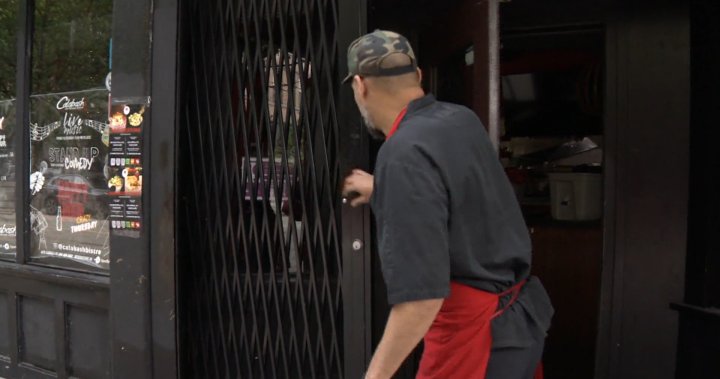As the gray autumn light filters through rain-streaked windows in Vancouver’s Downtown Eastside, Roger Collins wipes down the counter of Calabash Bistro for what might be the last time. After 14 years of serving Caribbean cuisine and hosting cultural events, his restaurant stands on the brink of closure – not due to poor reviews or financial mismanagement, but because of what Collins describes as “living in a war zone.”
“I’ve watched this neighborhood change dramatically,” Collins tells me, his voice tinged with resignation. “We used to have lineups down the block. Now customers are afraid to walk to our front door.”
Calabash Bistro announced its imminent closure last week through social media, citing an untenable security situation that has driven away patrons and left staff fearful. The decision reflects a growing crisis among small businesses in one of Canada’s most troubled urban districts.
The bistro’s struggle isn’t isolated. According to the Downtown Vancouver Business Improvement Association, commercial vacancies in and around the Downtown Eastside have jumped nearly 30% since 2019. More troubling is the reason behind these closures – a persistent cycle of property crime, open drug use, and what local owners describe as institutional abandonment.
Vancouver Police Department data shows commercial break-ins in the district have increased 37% over the past two years. For Collins, these statistics materialized as six break-ins within eight months, costing over $40,000 in damages and stolen equipment.
“Each time we repair, we’re gambling on whether we’ll make it through the night,” Collins explains, pointing to freshly installed security gates that have already been compromised twice. “The insurance companies don’t want to cover us anymore. We’re on our own.”
The Downtown Eastside has long been Canada’s most visible example of urban poverty and addiction challenges. The neighborhood’s proximity to Vancouver’s financial district and tourist areas creates a stark juxtaposition that has defied decades of intervention attempts.
Patricia Thompson, executive director of the Strathcona Business Improvement Association, believes the current crisis represents a breaking point for many establishments that weathered COVID-19 only to face mounting security concerns.
“These aren’t just businesses – they’re community anchors,” Thompson explains during our walk through streets dotted with boarded storefronts. “When places like Calabash close, we lose more than meals and jobs. We lose gathering spaces that give neighborhoods their identity.”
City councillor Sarah Kirby-Yung acknowledges the gravity of the situation but points to competing priorities. “We’re dealing with a complex social emergency that requires provincial leadership on mental health and addiction services,” she tells me by phone. “Meanwhile, small businesses are caught in the middle, trying to survive day by day.”
For Collins, the daily struggle became unmanageable when staff began refusing evening shifts due to safety concerns. Several employees reported being threatened while walking to public transit after closing. One cook quit after being assaulted on his way to work.
“I can’t in good conscience ask my team to put themselves at risk,” Collins says. “And I can’t run a restaurant without staff.”
The human cost extends beyond business owners. Calabash employed 22 people, many from the surrounding community. Line cook Marlene Jenkins, 54, has worked at the bistro for nine years and now faces uncertain prospects.
“This job helped me stay housed in this neighborhood,” Jenkins explains while preparing what may be her final service. “The places hiring right now are all downtown or in Kitsilano. That’s a long commute on minimum wage.”
Provincial data reveals an uncomfortable truth: while crime statistics fluctuate, perception of safety can determine a neighborhood’s economic viability. A recent BC Chamber of Commerce survey found 63% of potential customers avoid certain Vancouver areas due to safety concerns, regardless of actual crime rates.
Some business owners have adapted by adjusting hours, installing expensive security systems, or hiring private guards. The Eastside Culture Crawl, a major art event that once brought thousands of visitors to the district, now provides shuttle services between venues so attendees can avoid walking certain blocks.
These measures represent unsustainable costs for small margins businesses like Calabash. Collins estimates security expenses alone have increased his overhead by nearly 20% in the past year.
“We’re not a multinational chain that can absorb these losses,” he says. “Every broken window is another week we can’t make payroll.”
Mayor Ken Sim’s administration has promised enhanced policing through the controversial hiring of 100 new officers focused on high-need areas. Critics argue this approach fails to address root causes, while supporters maintain that basic security is prerequisite to any longer-term solutions.
As we finish our conversation, Collins serves jerk chicken to a table of loyal regulars who’ve come for one last meal. The restaurant is surprisingly busy – a bittersweet reminder of what might have been under different circumstances.
“People are showing up to say goodbye, but where were they all year?” Collins wonders aloud, though he quickly corrects himself. “That’s not fair. I don’t blame customers for being scared. I blame a system that let things deteriorate this far.”
As evening approaches, staff members begin removing Caribbean artwork from walls and packing away memorabilia. The bistro’s signature rum collection – once featuring over 100 varieties from across the Caribbean – has dwindled to a handful of bottles behind reinforced glass.
Outside, a small but determined group of community advocates has gathered with signs reading “Save Our Neighborhood Businesses.” Their presence underscores the reality that Calabash’s story represents more than one restaurant’s misfortune – it signals a tipping point for an entire district’s economic ecosystem.
Whether this latest closure will prompt meaningful action remains to be seen. For Collins and his staff, the immediate future holds uncertainty and difficult transitions. For the Downtown Eastside, it marks another lost light in a neighborhood fighting to maintain its commercial vitality amid profound social challenges.
“I still believe in this community,” Collins says as he locks up, perhaps for the final time. “But right now, believing isn’t enough to keep our doors open.”






